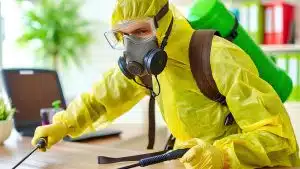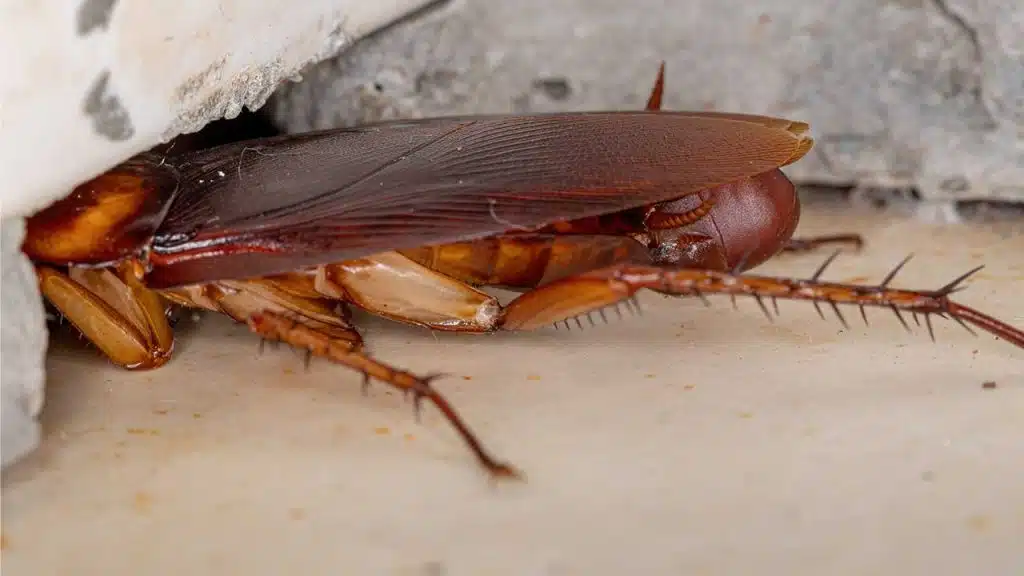


American cockroaches are larger than German cockroaches and prefer moist environments. German cockroaches, smaller in size, are more common in residential spaces.

Understanding the differences between American and German cockroaches is crucial for effective pest control. American cockroaches typically measure around 1. 5 inches in length and exhibit a reddish-brown color. They thrive in warm, damp areas like sewers and basements. On the other hand, German cockroaches are about half an inch long and are light brown with two dark stripes on their back.
They often infest kitchens and bathrooms. Recognizing these pests is the first step in addressing an infestation. Quick identification and knowledge of their habitats can help homeowners take prompt action to mitigate these unwelcome guests.
Discover the world of household roaches. Understand their habits and differences. Two common types stand out: the American Cockroach and the German Cockroach. They are not welcome guests in any home. Let’s explore their profiles and learn how to identify them.
Size: Large, can grow up to 3 inches
Color: Reddish-brown with a yellowish figure 8 pattern on the back of their heads
Habitat: Prefers warm, damp environments like sewers and basements
Diet: Omnivorous, will eat anything
Lifecycle: Up to 2 years
Behavior: Fast runners, usually nocturnal
Size: Smaller, around 0.5 inches
Color: Light brown to tan with two dark stripes behind the head
Habitat: Loves kitchens and bathrooms
Diet: Eats food crumbs and residue
Lifecycle: 6 months
Behavior: Prefers hiding and infests quickly
Let’s dive into the Physical Attributes of two common cockroaches. We’ll explore how American and German cockroaches look different.
Understanding size and color helps us tell these pests apart.
Type | Size | Color |
|---|---|---|
American Cockroach | 1.5 to 2 inches | Reddish-brown |
German Cockroach | 0.5 to 0.7 inches | Light brown to tan |
The American cockroach is larger and darker than the German cockroach.
Each cockroach has unique features.
American Cockroach – Has a yellow figure 8 pattern on its head.
German Cockroach – Features two dark stripes running down its back.
These marks make them easy to identify.
Exploring the habitats and behaviors of cockroaches reveals a world of difference. Two common types are American and German cockroaches. Let’s dive into their lifestyles.
American cockroaches favor warm, damp areas. They thrive in basements, sewers, and near pipes. Outdoors, they inhabit compost heaps and woodpiles.
German cockroaches prefer indoor habitats. They are often in kitchens, bathrooms, and areas with food.
American: Basements, sewers, yards.
German: Kitchens, bathrooms, appliances.
Both types are active at night. They forage for food and water in the dark. When lights turn on, they scurry to hide.
Cockroach Type | Night Behavior |
|---|---|
American | Search for food outside |
German | Stay indoors for food |
Both avoid light and prefer darkness. This is when they are most active.
The life cycles and reproductive habits of cockroaches are fascinating. American and German cockroaches differ significantly in these aspects. Understanding their unique life stages can help in effective control strategies. Let’s delve into the transformation from egg to adult, and their reproductive rates.
American Cockroaches begin as eggs. The female produces an egg case, called an ootheca. Each ootheca holds about 16 eggs. After about 6-8 weeks, nymphs hatch. These nymphs undergo 10-13 molts before becoming adults. The process takes about 6-12 months.
German Cockroaches also start from eggs. Their ootheca can contain up to 48 eggs. Nymphs emerge in about a month. They pass through 6-7 molts over a period of 2-6 months before reaching adulthood.
American Cockroach females can produce an ootheca every month. They may create 6-14 oothecae in their lifetime. This can lead to a significant number of new cockroaches over time.
German Cockroach females are more prolific. They can produce more oothecae, approximately 4-6, throughout their life. However, with more eggs per case, they can yield a larger number of offspring.
Type of Cockroach | Eggs per Ootheca | Time to Hatch | Time to Adult | Oothecae per Lifetime |
|---|---|---|---|---|
American Cockroach | 16 | 6-8 weeks | 6-12 months | 6-14 |
German Cockroach | Up to 48 | About 1 month | 2-6 months | 4-6 |
In summary, German cockroaches can reproduce faster than American cockroaches. They have a shorter cycle from egg to adult. This makes them more challenging to control.
Let’s explore the dietary preferences of two common cockroaches. These are the American and German cockroaches. Their meals might surprise you!
The American cockroach and the German cockroach have different meals. This is interesting!
American cockroaches love sweets and meats.
They also eat things like cheese, beer, and leather.
German cockroaches prefer meat and fatty foods.
They also munch on sweets, book bindings, and glue.
Both cockroaches are good at finding food. They eat almost anything!
Type | Adaptable Foods |
|---|---|
American Cockroach | Sweets, Meats, Cheese, Beer, Leather |
German Cockroach | Meat, Fatty Foods, Sweets, Book Bindings, Glue |
These cockroaches adapt to their environment. They eat a wide range of foods.
Credit: www.bettercallbugtech.com
American cockroaches and German cockroaches are common pests. They threaten health by spreading diseases. Let’s explore the risks.
These insects carry harmful germs and allergens.
Cockroaches pick up pathogens from decaying matter.
They spread these germs across surfaces.
Their droppings contain allergens.
These can trigger asthma attacks.
Infections and allergies can arise from infestations.
Disease | Source | Effect |
|---|---|---|
Salmonella | Cockroach feces | Food poisoning |
E. coli | Contaminated surfaces | Severe stomach cramps |
Children and the elderly are most at risk.
Prevent cockroach infestations to protect your family.
Controlling and eradicating roaches are key to a pest-free home. American and German cockroaches differ in behavior and habitat. But, both can be tackled with the right strategies. Let’s dive into the methods that work best against these pests.
Baits, traps, and insecticides are popular in roach control.
Baits lure roaches with food and poison them.
Traps capture roaches using a sticky surface.
Insecticides spray directly on roaches or in their paths.
Professional exterminators may use more advanced methods like heat treatment.
Prevention is better than cure. Keep roaches at bay with these steps:
Measure | Description |
|---|---|
Seal Cracks | Block entry points in walls and foundations. |
Clean Regularly | Remove food particles and clutter. |
Dry Surfaces | Fix leaks and avoid standing water. |
Store food in airtight containers and use trash cans with lids.
Credit: www.fullscopepestcontrol.com
Two common invaders in homes are American and German cockroaches. They are known for their toughness and ability to survive in various environments. This section dives into their survival tactics, including resistance to pesticides and innate survival skills.
Cockroaches have become notorious for outsmarting control methods. Their ability to resist pesticides is a major concern. Over time, these pests have developed mechanisms that render many chemical treatments ineffective.
Genetic Adaptations: Changes in their genetic makeup allow them to survive chemicals.
Behavioral Changes: They avoid areas treated with pesticides.
Enzyme Production: They produce enzymes that break down toxic substances.
Both American and German cockroaches have impressive survival skills. These skills ensure they thrive even in tough conditions.
Skill | American Cockroach | German Cockroach |
|---|---|---|
Speed | Can run up to 3 miles per hour | Quick to hide when disturbed |
Eating Habits | Eats anything organic | Consumes a variety of foods |
Reproduction | Produces many eggs | Can breed faster than others |
These roaches can live without food for a month and water for two weeks. They can even survive without their head for a week! Such skills make controlling them a challenge.
The ‘Environmental Impact’ of cockroaches is often overlooked. These pests play roles in ecosystems. Yet, some impacts are harmful. Let’s explore American and German cockroaches’ effects.
American and German cockroaches can influence ecosystems. They aid in breaking down organic matter. This process enriches the soil. However, large populations may disrupt this balance. Cockroaches can consume seedlings. This harms plant diversity.
Cockroaches decompose dead plants and animals.
They provide food for predators like birds and spiders.
Excessive numbers can lead to overconsumption of resources.
Cockroaches interact with other species. They can impact biodiversity in several ways:
Impact | American Cockroach | German Cockroach |
|---|---|---|
Pollination | Minor role | Rarely pollinates |
Seed Dispersal | Can spread seeds | Less likely to spread seeds |
Food Chain | Prey for many species | Prey for fewer species |
Both types of cockroaches can carry diseases. They affect human health and habitats. This has a knock-on effect on local wildlife.
Cockroaches spread microbes and allergens.
They can trigger asthma attacks in children.
Infestations lead to the use of pesticides, which harm other species.
Credit: www.masseyservices.com
Distinguishing between American and German cockroaches is crucial for effective pest control. Each species thrives in different environments and requires specific eradication strategies. Remember, identifying the type early on helps in choosing the right treatment approach. Armed with this knowledge, tackling a cockroach infestation becomes a more manageable task. Keep your space clean and consult professionals for the best results.
The worst roaches to have are German cockroaches. They reproduce quickly, are hard to eliminate, and can spread diseases. Their adaptability to indoor environments makes them particularly challenging to control. Avoiding them requires proactive measures in cleanliness and prompt extermination efforts.
The most troublesome roaches are German cockroaches due to their rapid reproduction and resilience to common pest control methods.
Yes, American cockroaches can be difficult to eliminate due to their fast breeding and adaptability to various environments. Regular pest control measures are often necessary to fully remove them from a property.
Yes, American roaches do infest homes and buildings. They seek warm, moist environments and can quickly establish large populations. Regular pest control measures are essential to prevent and reduce their infestation.
American cockroaches are larger, reddish-brown, and prefer damp environments, while German cockroaches are smaller, lighter-colored, and often found indoors.